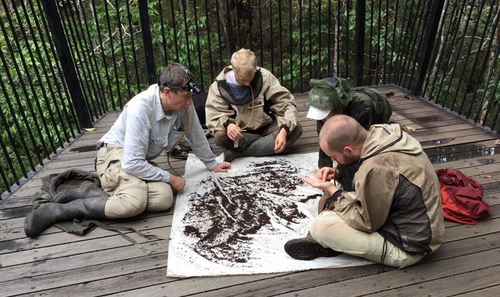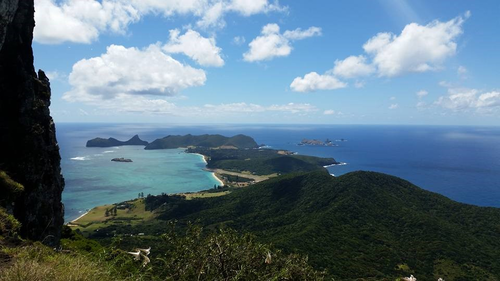This article was written by Josh Jenkins Shaw.
The rove beetle subtribe Amblyopinina is a signature group of about 400 species in the southern hemisphere with major species diversity in Australia, New Guinea, New Zealand, New Caledonia and South America. Most Amblyopinines are free-living rove beetles, which can be found in leaf litter and other decaying materials. About 65 species are adapted to live in the fur and burrows of mammals where they are predators on mammal ectoparasites such as fleas. Despite being an important component of the southern hemisphere biodiversity, having an interesting transcontinental distribution and expressing a unique relationship with mammals, the group has never been thoroughly explored in a phylogenetic context.

Looking for beetles in sifted leaf litter in Queensland, Australia with Dr. Alexey Solodovnikov and Aslak Hansen.
The major goals of my PhD based at the Natural History Museum of Denmark and the University of Copenhagen are to taxonomically revise the subtribe at the generic level, to reconstruct the first phylogeny of the subtribe based on morphological and molecular data and to taxonomically revise the Amblyopinine fauna of Lord Howe Island. The taxonomic and phylogenetic research I am undertaking is the first step towards making Amblyopinines a model group for studies in evolutionary biology, biogeography and other fields of natural science. With morphological and molecular data now in place, recent developments have been the construction of the first phylogenetic trees, which show several interesting things, which will be published in due course.
For me, one of the most rewarding and educational aspects of my PhD research has been the opportunity to visit the places where Amblyopinines and other organisms live. In early 2017, I spent 2 weeks on Lord Howe Island, an oceanic island in the Tasman Sea 780km North-east of Sydney and 2 weeks in the rainforests of Queensland.

Looking out over the Northern part of Lord Howe Island
On both occasions the focus was collecting beetles for molecular and taxonomic work, however being immersed in the environment and biodiversity allowed me to develop a much stronger understanding of where the beetles live and some of the issues facing the environment and biodiversity more broadly. Such experiences have also been essential for generating ideas and hypotheses on current and future research projects.
BIG4 allowed me to meet and learn from both early career researchers and established scientists. The workshops, formal and informal discussions enabled the exchange of ideas and the development of collaborative research. BIG4 helped me learn about future career opportunities outside academia. I will utilize the amazing source of knowledge that BIG4 gave me for the rest of my scientific career.
Publications within this project:
- Jenkins Shaw, J & Solodovnikov, A. 2016. Systematic and biogeographic review of the Staphylinini rove beetles of Lord Howe Island with description of new species and taxonomic changes (Coleoptera: Staphylinidae). ZooKeys 638: 1-25. DOI: https://doi.org/10.3897/zookeys.638.10883
- Solodovnikov, A & Jenkins Shaw, J. 2016. Remarkable Australian rove beetle genus Myotyphlus: its cryptic diversity and significance for exploring mutualism among insects and mammals (Coleoptera: Staphylinidae: Staphylininae). Austral Entomology 56: 311-321. DOI: https://doi.org/10.1111/aen.12233
- Jenkins Shaw, J., Żyła, D. & Solodovnikov, A. 2017. A spectacular new genus of Staphylinini rove beetle from the Tropical Andes and its phylogenetic assessment (Coleoptera: Staphylinidae). Invertebrate Systematics 31 (6): 713-722. DOI: https://doi.org/10.1071/IS17020

